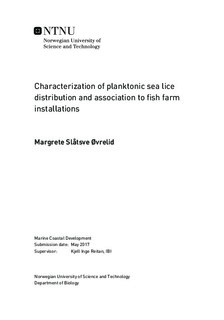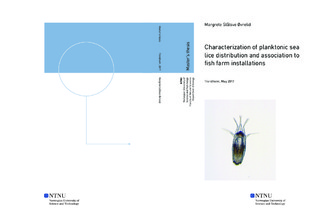| dc.description.abstract | Lepeoptheirus salmonis (Krøyer 1837) and Caligus elongatus (Normann 1832) are the sea lice species posing the biggest threat to both farmed and wild salmonid stock in the Northern hemisphere today. The three first stages are planktonic, and the transmission of sea lice within farms, and between farms and wild fish happens mainly in these stages. Today it is limited observation on planktonic sea lice distribution in and around fish farms, and it is a need for more knowledge on how the planktonic stages of sea lice are distributed in association to sea cages. Such knowledge is important to get a better understanding of sea lice dispersion and infection mechanisms at salmon farms.
In this regard distribution of planktonic stages of sea lice inside and outside of sea cages in a fish farm were investigated by conducting horizontal plankton tows. The plankton tows were taken at two different farms, one wearing skirts and the other one without. How biofouling and washing activities may affect the distribution of sea lice were documented by taking plankton tows in relation to fouling on the net, and in different times of the washing cycle. A hatching experiment were conducted to characterize the planktonic stages of L. salmonis and C. elongatus, which was further used to differentiate between species in the plankton tows.
The results showed that live planktonic L. salmonis and C. elongatus had characteristic pigmentation, and differed in size. However, due to loss of pigmentation, individuals fixated on formaldehyde (4%) could not be specified further than to family (Caligidae). Regarding the prevalence of L. salmonis and C. elongatus in Norway, it is likely that the planktonic sea lice found in the plankton samples belonged to these two species. The result from the plankton surveys showed that nauplii were the most abundant planktonic life stage in the water column at fish farms. Planktonic sea lice was shown to be retained inside the sea cages wearing skirts. No such effect of sea cages not wearing skirts were detected, and sea cage nets did not seem to hinder the transport of planktonic sea lice to the surrounding water to a very high degree. Biofouling of the net could to some extend retain sea lice inside of the cage, most possible due to reduced water flow. It was not found an elevation of sea lice larva in the water masses immediately after cleaning of the nets, thus it did not seem that the planktonic stages of sea lice stay in the biofouling, and it is not likely that cleaning activities of the sea cage could be a source of infection by releasing pre-infective and infective larvae. | |

